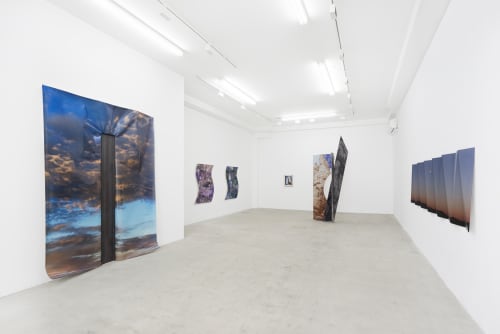Letha Wilson: Horizon Eyes
GRIMM is pleased to announce Horizon Eyes, a solo exhibition of new works by Letha Wilson, on view at our New York gallery space. This marks the artist’s second solo exhibition with GRIMM, showcasing a selection of new sculptural works that combine landscape photographs with industrial materials like aluminum, zinc, concrete and steel.
Throughout her career, Letha Wilson has expanded boundaries between photography and sculpture by questioning how a photograph can be physically engaged. Wilson trades the traditional confines of a photographic image by merging them with monumental materials that complicate the duality between the natural landscape and our industrial, synthetic society. Using landscape photography as a source, Wilson’s balance of material and image speaks to our relationship with the landscape, using both intimate and vast details of nature as subject.
Our relationship to the scale of the work often refers to the landscape as subject, whether we are confronted with a 10-foot photograph of Bryce Canyon, UT (US) printed on steel, or Headlands Beach Steel Pipe Bend that presents the fleeting moment of a sunset as a soft, malleable form, bearing the weight of the steel pipe. In a work spanning 14 feet wide, a color field-like sunset in northeast Nevada is folded as an accordion, mimicking the panoramic experience of looking at something that can never be viewed entirely at once. Concrete works themselves are a journey in chemical manipulation, where the emulsion from traditional C-print photographs are cured into the face of the concrete, abstracted and repeated onto themselves.
Proposing a new physical presence that has a life of its own beyond the original photograph, the work is as much about its own material as the image that it was born from. The works in Horizon Eyes contain photographs from sites Wilson has traveled to, including the Western United States, Hawaii, and Iceland. Images taken on site are later manipulated in her studio, amalgamated with industrial materials like zinc, aluminum, and steel that aim to pull something out of the images. These materials are exposed, revealing architectural qualities that interrogate interior and exterior spaces.
Color and form are explored in works that are folded, bent, torn and cut, alluding to Wilson’s control of material and space; their final textures referring back to natural terrains. Through these gestures, Wilson creates abstract works that speak to our complex relationship with the natural world.










